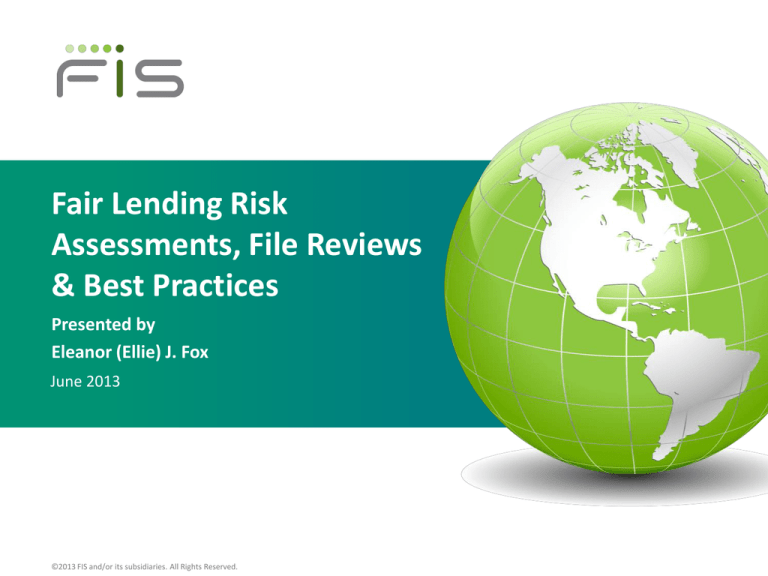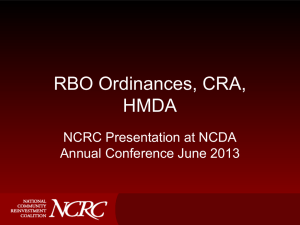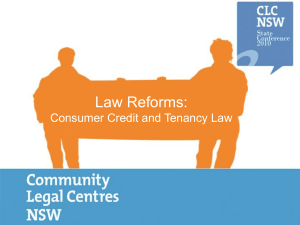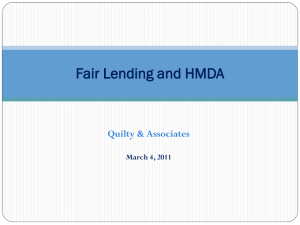
Fair Lending Risk
Assessments, File Reviews
& Best Practices
Presented by
Eleanor (Ellie) J. Fox
June 2013
©2013 FIS and/or its subsidiaries. All Rights Reserved.
Fair Lending Risk Assessment (FLRA)
• The general components of a FLRA include off-site and on-site analysis:
• Off-site analysis of HMDA Data
•
– FIS EGRC Solutions spreads data utilizing Centrax mapping software
– Analysis reveals statistical evidence of potential discrimination
On-site analysis; review of documentation
– Checking most recent compliance examination and audit reports for fair lending issues
– Reviewing general and specific loan policies for clear and consistent underwriting standards
and guidelines
– Reviewing marketing materials including website and social media for use of diverse cultures
and images
2
FLRA Interviews
• On-site Analysis: Interview Management
– Each FLRA reveals the appropriate person to interview but generally, it is helpful to start
with the person responsible for HMDA accuracy and completion
• If there have been multiple issues with HMDA accuracy and completion, then the off-site analysis may be
compromised
• If there has been significant turnover in this area, then additional training may be needed to avert future
issues
• Every effort should be made to interview someone who actually speaks to the applicant. This could be
an originator who takes an application or follows up on ‘e’ applications.
3
FLRA Interviews …
• From a list of over 200 potential questions, choose 7 – 10 that apply to the
institution and interviewee
• Incorporate questions that arose as a result of documentation review
• The goal is to ensure that the person being interviewed understands the policy and
procedures and applies them appropriately
• Determine whether the interviewee encourages applications, even when initial
information makes it unlikely to be approved (e.g., applicant shares they just
finished bankruptcy).
4
Underwriting Risks
• Higher denial rates for minority populations vs. white populations
• Shorter or longer days to decide for one group vs. another
• Loan origination compensation based on dollars of loans vs. numbers of loans
• Lack of a second review for denials
• Lack of exception tracking
• Lack of annual exception analysis
5
Collection / Servicing Risks
• General loan policies silent on fair lending and Servicemembers Civil Relief Act
•
•
•
•
•
•
•
(SCRA) even when financial institution has a separate fair lending or SCRA Policy
Minimal explanation of concessions and modifications
Failure to reference Fair Debt Collection Practices
Failure to reference Credit Counseling
Failure to document state collection or servicing requirements
Inadequate consumer complaint tracking
Inconsistent and/or inaccurate reference to prohibited bases
Incomplete complaint process
6
Redlining & Marketing Risk
• Redlining Risk - The percentage of applications from minority census tracts with
greater than 80% minority population is low compared to the number of minority
majority census tracts in the assessment area (AA).
– Example: Receiving 1% of all applications from “minority-majority” census tracts when those
census tracts comprise 12% of the assessment area population. Implies an attempt to carve
out these geographies.
• Marketing Risk – The percentage of applications from minority populations is low
compared to the population within the entire AA.
– Example: Receiving 1% of applications from Hispanic applicants when the Hispanic
population makes us 8% of the entire AA.
7
Observations / Recommendations
• Most institutions:
– Reference all federal, but not state prohibited bases. We recommend creating an appendix
detailing federal prohibited bases (by law/regulation) and then state specific prohibited bases
for all states in which the institution lends.
– Omit reference to SCRA in servicing or collection policies. We recommend including a
reference to SCRA or at least to a separate, standalone SCRA Policy
– Omit fair lending guidelines or code of conduct guidelines in their compensation agreements
with originators. With the new MLO rules taking effect in January 2014, now is a good time
to update these agreements.
– Collect underwriting exception date on individual loans, but don’t create any aggregate
reports. We recommend documenting exceptions made for consumer, residential and
commercial loans.
8
Observations / Recommendations (continued)
• Most institutions:
– Never escalate exceptions to the board level directly or by Loan Committee minutes –
recommend escalating monthly and sharing semi-annual analysis
– Omit any kind of analysis on the exception loans they do collect – recommend at least a semiannual review of aggregate loan exceptions by type with subsequent annual sharing with the
board
– Limit training to lenders or only some lenders – recommend including all lenders and
marketing at a minimum; much better to include all employees and of course the Board
9
Comparative File Review – Target Group
• When a statistical risk develops from a FLRA, it is important to review the
underlying files to ensure that there is no evidence of discriminatory activity
• A comparative file review includes the target group (e.g., 15 denied black
applicants)
– Review these files in great detail, documenting the Housing, LTV and DTI ratios as well as
anything of significance on the credit bureau reports
– Ensure that an appropriate credit decision was made, based upon the facts and supporting
information
– Ensure that there was a more than cursory second review process
10
Comparative File Review – Control Group
• A comparative file review includes a control group
– Adhere to FFIEC guidance in determining the appropriate size for the control group (e.g., 100
approved White applicants)
• Once the data is collected on both groups, we further analyze it to see if there are
any anomalies
– Were the Black applicants denied for exceeding policy ratios?
– Were any White applicants approved even though they also exceeded policy ratios?
11
Observations
• Most Institutions:
–
–
–
–
Do not believe they act in a discriminatory manner
Do not analyze their HMDA data to identify potential risks
Do not conduct file reviews of these potential risks
Do not have a defense prepared when examiners raise same issue
• Example – One Lender did not have discriminatory behavior but because they miscoded applications as
withdrawn, rather than approved not accepted, the statistics indicated strong concern with ‘days to
decide’
• Example – Another Lender provided monthly exception reports; when they aggregated quarterly, they
found exception rates over 25%. They increased their DTI ratio from 36% to 40% and eliminated
exceptions.
12
Fair Lending Red Flags
Watch out for Fair Lending Red Flags
• Red Flag #1: Disparate impact that may not be readily apparent
– If disparate impact could exist or is suspected, conduct a “disparate impact analysis,” to
ensure whether an adequate business justification exists and whether there is a less
discriminatory alternative that could achieve the same results.
• Red Flag #2: Lending policies that require a minimum loan amount
– Although these guidelines are facially neutral, they have led to numerous fair lending
complaints and settlements because of the perception that minimum loan amounts have a
disparate impact on minority borrowers who are more likely to require lower loan amounts.
• Red Flag #3: Credit overlays to underwriting guidelines
– Credit overlays present a fairness risk in that similarly situated consumers are treated
differently. Examples of credit overlays include:
• Imposing higher minimum FICO scores for FHA loans
• Requiring applicants on maternity leave to return to work before closing a loan
• Requiring applicants on permanent disability to provide proof of the continuation of the disability from a
doctor
14
Fair Lending Red Flags (continued)
• Red Flag #4: Lack of periodic risk assessments to evaluate level of consumer
compliance risk (including fair lending risk)
– Federal regulators expect depository institutions of all sizes to conduct periodic risk
assessments of its operations to evaluate compliance with applicable laws and regulations.
• Red Flag #5: Use of discretion in consumer lending and loss mitigation
– Policies and procedures often permit loan officers, underwriters or agents (e.g., auto dealers)
to exercise discretion in pricing or credit decisions. Discretionary practices may also arise in
areas such as account maintenance (e.g., fee waivers), collections, and loan modifications.
• Red Flag #6: Failure to evaluate fairness risks and controls for non-HMDA loans
– Although fair lending exams and enforcement actions have historically focused on mortgage
lending, that no longer holds true. Recently, attention has been increasingly focused on nonHMDA lending (e.g., indirect auto lending, student lending, credit cards, and unsecured
consumer lending).
– In the absence of HMDA data to serve as the basis of a fair lending claim, the government has
relied on “proxy” data (e.g., geocoding, surname) to conduct quantitative analyses.
15
Thank you!
Eleanor (Ellie) J. Fox
Assistant Director, New England Region
FIS Enterprise Governance, Risk & Compliance
(EGRC) Solutions
978.778.8670
Eleanor.Fox@fisglobal.com










